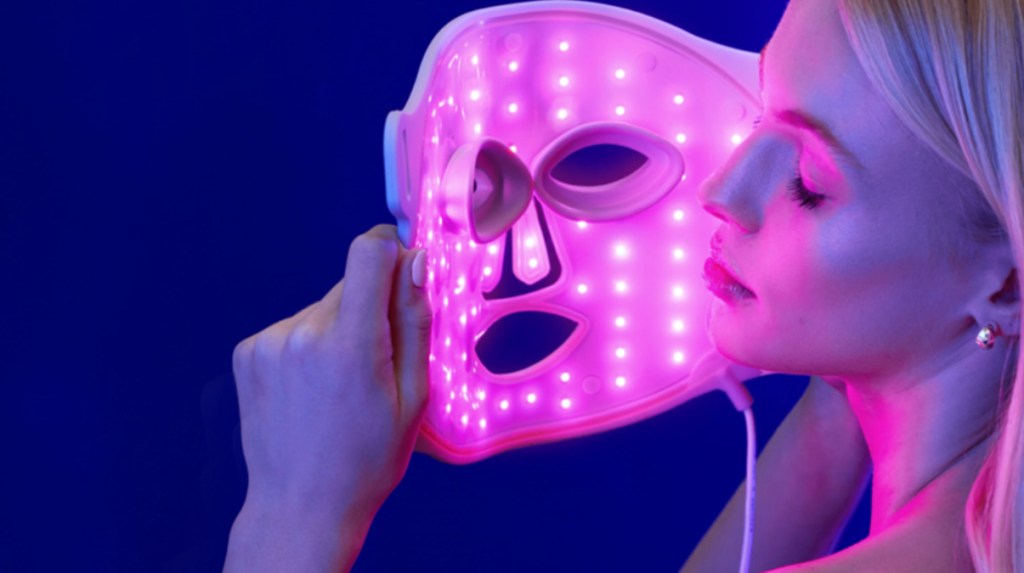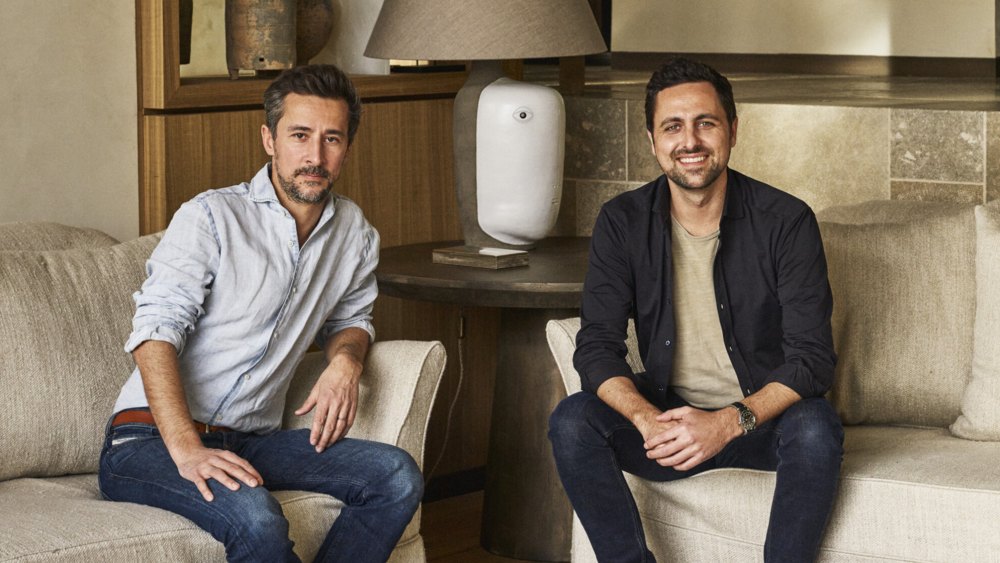If you purchase an independently reviewed product or service through a link on our website, WWD may receive an affiliate commission.
While skin care regimens usually entail a few potent face serums, moisturizer, and sunscreen, shoppers have more options than topical ingredients to target skin concerns. One such example? Blue light therapy. This type of LED treatment using blue light wavelengths has been employed by dermatologists and facialists to treat skin concerns like acne and sun damage.
As one of the most well-studied light therapies for skin issues, blue light therapy benefits most notably include the management of acne, as the technology’s wavelengths help destroy a specific bacteria that’s responsible for causing certain types of breakouts.
Since blue light therapy, when used alone, is noninvasive, painless, and has shown to be well-tolerated on different skin types, at-home blue LED light therapy skin care tools have been growing in popularity over recent years. (On TikTok, curiosity for blue light therapy for acne has garnered the term over 102 million views.) But is opting to forgo the dermatologist’s office and DIY this skin care regime with an LED face mask recommended by the pros? We consulted with three board-certified dermatologists and a board-certified facial plastic surgeon to find out.
What Is Blue Light Therapy?
Blue light therapy uses a specific range of blue light wavelengths from 380 to 500 nanometers (typically around 400 to 495 nm) that penetrates the epidermis to provide skin benefits. When used alone in a dermatology office or with an at-home device, blue light therapy is completely painless and noninvasive.
Dermatologists also will often use blue light treatment for cancerous and precancerous skin as a part of photodynamic therapy, which employs photosynthesizing (or light-sensitive) medication and high-intensity blue light to activate them. First, the dermatologist applies the photosensitizing medication to the affected skin area and lets it absorb into the skin for one to two hours. Then, the doctor will shine blue light onto the treated skin area for approximately 15 minutes, which purposely causes inflammation, causing the treated area to flake and eventually peel off. This procedure has shown to be effective for treating sun damage and even skin cancer when performed by a professional regularly — usually the treatment should be repeated two to three times about four to six weeks apart for best results. Photodynamic therapy should only be conducted by a dermatologist.
“Photodynamic therapy can be used for inflammatory cystic acne,” explains New York-based, board-certified dermatologist Dr. Paul Jarrod Frank. It does have recovery of several days, but is very effective in treating these conditions. When used alone for acne, it’s a very benign, very safe treatment — much less inflammatory or risky than the in-office procedure of photodynamic therapy.”
Dr. Frank cites noninvasive at-home treatments like LED light therapy face masks or handheld facial tools as potentially effective if used regularly. But he recommends getting treated with blue LED light therapy by experts, as he says, “You’re always going to get a stronger version of it in a professionals office where it can be monitored.”
Blue Light Therapy for Acne
After being researched for decades, blue light therapy was approved by the FDA for treatment of acne vulgaris in 2002. Specifically, the first FDA-approved blue light skin therapy device for acne was ClearLight Acne Photoclearing System, created by Israeli company CureLight. The device produces high-intensity blue light that penetrates the skin and kills the acne-causing bacteria without damaging surrounding tissue.
“Blue light therapy is a go-to for combatting congestion and treating moderate acne,” explains board-certified New York City dermatologist Dr. Dendy Engleman. “It is a great, safe, and noninvasive option for helping treat and even prevent acne breakouts because it targets and destroys Propionibacterium acnes, a bacterium found on the skin that is responsible for acne.”
Dr. Engleman notes that combined with red light therapy, blue light therapy could deliver more acne-clearing benefits. “The wavelengths are able to reach only the epidermis, which is the uppermost layer of the skin, but when combined with red light it can penetrate deep into the dermis and treat inflammation and cystic acne as well as boost the body’s natural repair system,” she explains.
While the American Academy of Dermatology acknowledges that blue light therapy works in combination with other acne treatments to help clear skin, the organization cautions that blue light therapy is not a guarantee of a 100 percent cure of acne, that results vary based on the individual, and that results take time over a series of treatments.
“Clinical studies have shown that 85 percent of patients demonstrated a reduction in at least 50 percent of their acne lesions after completing four blue light therapy treatments, with approximately 75 percent clearance at three months after their last treatment,” says double board-certified facial plastic surgeon Dr. Jennifer Levine. “This has been linked to blue light therapy’s ability to kill acne-causing bacteria and regulate oil production.”
However, it should be noted that blue light therapy is not effective on all types of acne. This treatment is designed to help clear mild to moderate inflammatory acne — red, inflamed pimples — and not whiteheads, blackheads, or cystic acne (the most severe type of acne vulgaris). But when used as part of photodynamic therapy, blue light therapy has shown to be more effective for these severe types of acne, according to a study conducted by Dr. Macrene Alexiades, founder of MACRENE actives and associate clinical professor at Yale University School of Medicine.
Similarly, Dr. Frank notes, “Blue light therapy has been used for many years with acne. Acne is a very difficult skin disease to treat, and although it is hopeful, it should not be used as the primary and only treatment for acne. Most forms of LED light therapy are a good supplement to other treatments of any condition.” In other words: Blue light therapy should be used in combination with acne treatments suggested by your medical provider, whether that’s a retinol product, a moisturizer for acne-prone skin, or a medicated acne spot treatment.
Blue Light Therapy at Home
Since blue light skin therapy is noninvasive, safe, and gentle, it’s a treatment that can be done from the comforts of home with viable efficacy (just note that professional treatments will always be more effective).
“At-home blue light therapy devices offer convenience but require a large number of treatments and may vary in effectiveness,” Dr. Alexiades says. “It’s important to follow instructions carefully and to choose reputable products,” such as Omnilux Contour Face Mask and Therabody’s Theraface Pro. She also recommends Lustre ClearSkin Solo to treat acne.
Levine acknowledges an at-home blue light skin therapy device can be a great addition to a patient’s skin care routine, citing a study published in the Journal of Cosmetic and Laser Therapy focusing on at-home blue LED light therapy that showed significant reduction in acne lesion size in as few as two treatments.
“At-home devices are convenient and effective, making them a good option for people who want to treat easy-to-address areas such as the face, neck or hands,” she explains. “However, professional treatment may be necessary for hard-to-reach areas such as the back, and blue light therapy is usually part of a treatment plan, not a standalone treatment. Working with a professional can help resolve a skin condition quicker and prevent further challenges.”
Some LED masks might require you to wear it on your face for a few minutes each day, during which time you may sit upright or lie down. And with handheld devices, you might need to hold the tool six to 12 inches from your face for 10 minutes.
Dr. Dennis Gross DRx SpectraLite FaceWare Pro
Engelman says she favors the FDA-approved DRx SpectraLite FaceWare Proface mask by Dr. Dennis Gross — which is also the LED mask of choice for Kris Jenner and Rita Ora — because it has both red and blue light to help stimulate collagen production and target acne; plus, it’s easy to use at home.
Price upon publish date of this article: $465
LED Technologies dpl IIa LED Treatment Panel
The LED Technologies treatment panel has three light therapy combination settings, including options that marry red and blue light therapy to fight acne, as well as red, infrared, amber, and blue light that targets skin firmness, texture, and breakouts at once.
Price upon publish date of this article: $399
LightStim for Acne
A top-rated choice from testers, LightStim’s handheld blue light therapy tool zaps certain types of acne-causing bacteria. Use it daily for three minutes per treatment area.
Price upon publish date of this article: $169
Omnilux Clear Face Mask
Omnilux’s Clear Face Mask combines red and blue light therapy to treat active acne while helping to quell any related redness. The brand recommends completing four 10-minute treatments per week for best results.
Price upon publish date of this article: $395
Lustre ClearSkin Solo Blue Light Therapy Device
Recommended by Dr. Alexiades, this blue light therapy tool adheres to your skin to deliver blue light. Think of it as a souped-up pimple patch you only need to wear 20 minutes per day to clear up a problem area on your chin, cheek, or forehead.
Price upon publish date of this article: $89
More Benefits of Blue Light Therapy
While blue LED light therapy has been most researched for treating acne, it has also shown to have other benefits to vary degrees of success. Dr. Engelman notes that blue light therapy “is great for not only killing acne-causing bacteria, but also for improving the skin’s tone and texture.”
- Other skin conditions: Blue light therapy has been reported to “induce antiproliferative effects, which can be beneficial in treating conditions such as atopic dermatitis, eczema, and psoriasis,” notes Dr. Levine. A 2018 trial conducted in Germany and Switzerland supports this claim, finding that blue light has the potential to improve inflammatory skin diseases with minimal risks.
- Sun damage, pre-cancerous cells, and skin cancer: Blue light therapy works well as part of photodynamic therapy offered in a professional setting to treat Bowen’s disease, a very early form of skin cancer (also sometimes called squamous cell carcinoma) that’s indicated by a red, scaly patch on the skin, as well as other nonmelanoma skin cancers. A study published by Dr. Alexiades also revealed effectiveness of blue light therapy in treating actinic keratoses, precancerous patches or lesions on the skin, and actinic cheilitis, specifically actinic keratoses of the lips caused by sun exposure.
- Depression: “Although there is not enough research to support this claim, blue light therapy can potentially be used to help treat depression,” notes Dr. Engelman. “Some research shows there can be a positive link in treating seasonal depressive disorder or major depressive disorder with seasonal patterns [formerly called Seasonal Affect Disorder or SAD].” It seems plausible that blue light could help boost mood, substantial evidence of this benefit has been unfounded. Dr. Alexiades offers, “Exposure to blue light can theoretically influence the body’s circadian rhythms and melatonin production, potentially affecting mood. However, more research is needed to fully understand this connection.” Dr. Levine explains how the process of using blue light therapy can be part of a treatment plan for people afflicted with SAD by mimicking natural light and regulating melatonin production and circadian rhythms. “The wavelength and delivery of blue light therapy for SAD differs from that for skin treatments,” she says. “For SAD, the individual is exposed to a broader spectrum of blue light, which interacts with their eyes at a safe distance. For skin treatments, the blue light is typically set to a smaller range and is applied to the skin.”
Pros and Cons of Blue Light Therapy
Pros
The dermatologists we consulted seem to agree that since blue light therapy is noninvasive and safe, if you’re curious about blue light therapy, go for it. It’s worth a shot if topicals like acne serums or acne spot treatments have failed to effectively treat your breakouts.
In-office blue light therapy treatments conducted by a professional are fairly quick and easy. The process takes approximately 20 to 30 minutes, during which time a blue light source is placed close to a patient’s face. Patients can return to normal activity immediately following a blue light therapy session.
Through various research, blue light therapy has been shown to significantly improve inflammatory acne by killing acne-causing bacteria beneath the skin’s surface and targeting sebaceous glands to regulate oil production. And when incorporated as part of photodynamic therapy treatment or coupled with red light therapy, blue light therapy may also be able to target and assist in alleviating cystic acne. Blue light therapy is an FDA approved in-office treatment for actinic keratoses (precancerous lesions), and some insurance companies will even cover the cost of the treatment.
“The side effect profile is minimal to none when blue light therapy is used alone,” notes Dr. Frank, who adds, “There are at-home devices for just plain blue light that are very safe.”
But Levine urges, “If you are considering an at-home device, opt for one that is FDA-cleared and closely follow directions on how to use it.”
Cons
While blue light therapy may be helpful to treat acne and other skin disorders, Dr. Levine notes, “Blue light therapy has a more limited use in aesthetics [when compared to other LED treatments, like red light therapy, for instance] and, therefore, may not be helpful to all individuals.” Blue light therapy won’t be a fountain of youth for your skin, but it can help reverse some effects of skin damage.
A time commitment is also required to see substantial results from blue light therapy. A dermatologist may treat a patient with blue light therapy for 15 to 20 minutes for acne or up to 90 minutes as part of photodynamic therapy. Then after the initial in-office treatment, patients must return for follow-up therapy two or three times, approximately four to six weeks apart. And at-home blue light therapy is even more of a strict time commitment: Some at-home devices require twice daily use for 30 to 60 minutes for four to five weeks, while others necessitate regular use for just a few minutes per day several times a week. Dr. Frank recommends daily use of an at-home device to see top results.
Although, as mentioned repeatedly, blue light therapy is non-invasive and generally safe, and it can have very minor side effects such as skin dryness, itchiness, and irritation. Dr. Frank notes blue light therapy is not as dangerous as lasers, but, he says, “as with any light, if used excessively, it can cause eye damage and burns.”
Dr. Alexiades adds, “Common side effects of blue light therapy include temporary redness and dryness. It’s essential to use protective eyewear and follow recommended exposure times to avoid potential harm.” Blue light therapy as part of photodynamic therapy may cause skin irritation and photosensitivity; after photodynamic therapy with blue light therapy, patients should avoid sun exposure and be diligent about using face sunscreen.
All of our experts stressed repeatedly to follow professional recommendations and if using an at-home device to follow instructions perfectly. Dr. Alexiades urges, “For safe and effective use, follow the device instructions, wear protective eyewear, and be consistent in your treatment. Consult with a dermatologist before starting blue light therapy, especially for specific skin concerns.”
Why Trust WWD
Since 1910, WWD — often referred to as “the fashion bible” — has been the leading industry voice of authority for senior executives in the global women’s and men’s fashion, retail and beauty communities, while also informing the consumer media that cover the market. Today, WWD’s breaking news and trend coverage continues to be a trustworthy resource for both fashion insiders and consumers alike. Our shopping editors continue to uphold WWD’s editorial standards and values with quality, expert-backed product selections. Learn more about us here.
Meet the Experts

Dr. Dendy Engelman, MD, FACMS, FAAD, is a board-certified, award-winning, New York City dermatologist, Mohs surgeon, and media expert who specializes in medical and cosmetic dermatology at Shafer Clinic Fifth Avenue. She is a fellow of the American Academy of Dermatology, American Society of Dermatologic Surgery and American College of Mohs Surgery.

Dr. Macrene Alexiades, MD, Ph.D., FAAD, is a double board-certified dermatologist in the EU and the U.S., and is certified to practice medicine, surgery, and dermatology. She holds three degrees from Harvard University: a BA from Harvard University, MD from Harvard Medical School, and a PhD in Genetics from Harvard University. She was also a Fulbright Scholar with a research award year in Europe and has been named as a Castle Connolly Top Doctor since 2014. Today, she provides editorial expertise to multiple medical journals, and she delivers expert patient care at her bustling, high-profile New York City dermatology practice.

Dr. Jennifer Levine, MD, is an award-winning, double board-certified facial plastic surgeon, world-renowned beauty expert, and steadfast innovator. She has always had a profound appreciation for beauty, precision, and mathematics, solidifying her career in aesthetic medicine. In addition to running her private practice, Dr. Levine is an attending plastic surgeon at Manhattan Eye, Ear, and Throat Hospital and Lenox Hill Hospital.

Dr. Paul Jarrod Frank, MD, is a board-certified dermatologist and dermatologic surgeon, skincare consultant, and founder of the bespoke aesthetic healthcare brand PFRANKMD. In over 20 years of private practice, he has become a world-renowned expert in minimally invasive cosmetic surgery. He is also a clinical assistant professor of dermatology at The Icahn School of Medicine at Mount Sinai Hospital.
Meet the Author
Danine Alati is a WWD contributor who boasts over two decades of experience covering the beauty, wellness, and interior design verticals. Alati also specializes in writing luxury lifestyle and home improvement pieces, and has penned stories for InStyle, Architectural Digest, DuJour, Galerie, Brides, Hamptons, Art Basel, and Worth magazines, and many other outlets. Alati interviewed four leading dermatologists and conducted extensive research on blue light therapy to write this article on the benefits of the skin care technology.








